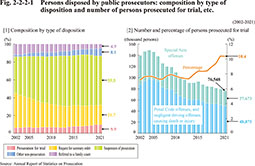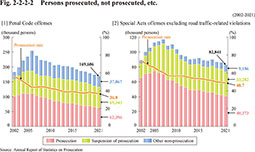Section 2 Dispositions
Where a public prosecutor decides to prosecute a person, they request a public trial or a summary procedure. A public prosecutor decides not to prosecute a person where [1] a precondition for prosecution (e.g., a victim’s complaint for certain offenses) is not satisfied, [2] the person’s act does not constitute an offense (or the person is not punishable due to insanity, etc.), or [3] evidence is not sufficient to prove an offense. A public prosecutor may also decide not to prosecute a case even where there is sufficient evidence to prove an offense if it deems unnecessary to be prosecuted based on factors such as suspect’s character, age, environment, gravity of an offense and circumstances during or after an offense (suspension of prosecution).
Fig. 2-2-2-1 shows, in relation to persons conclusively disposed by public prosecutors (including negligent driving offenses causing death or injury and road traffic-related violations), the trend in the composition of such persons by type of disposition and the number and percentage of persons prosecuted for trial.
Fig. 2-2-2-1 Persons disposed by public prosecutors: composition by type of disposition and number of persons prosecuted for trial, etc.
Click here for the Excel file (Japanese)
Fig. 2-2-2-2 shows the trend in the number of persons prosecuted or not prosecuted and the prosecution rate for [1] Penal Code offenses and [2] Special Acts offenses excluding road traffic-related violations.
Fig. 2-2-2-2 Persons prosecuted, not prosecuted, etc.
Click here for the Excel file (Japanese)
Table 2-2-2-3 shows the number of persons not prosecuted by reason of non-prosecution (excluding negligent driving offenses causing death or injury and road traffic-related violations) in 2021.
Table 2-2-2-3 Persons not prosecuted (by reason)


